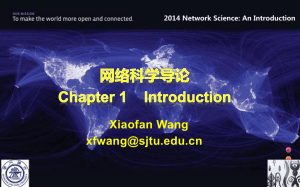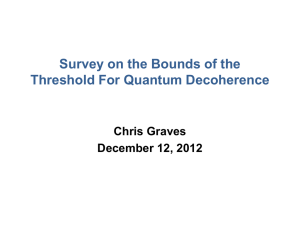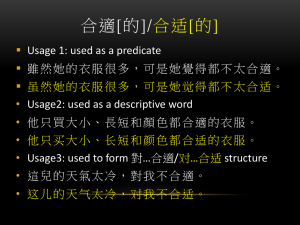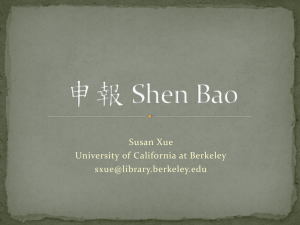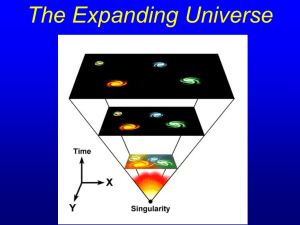Document
advertisement
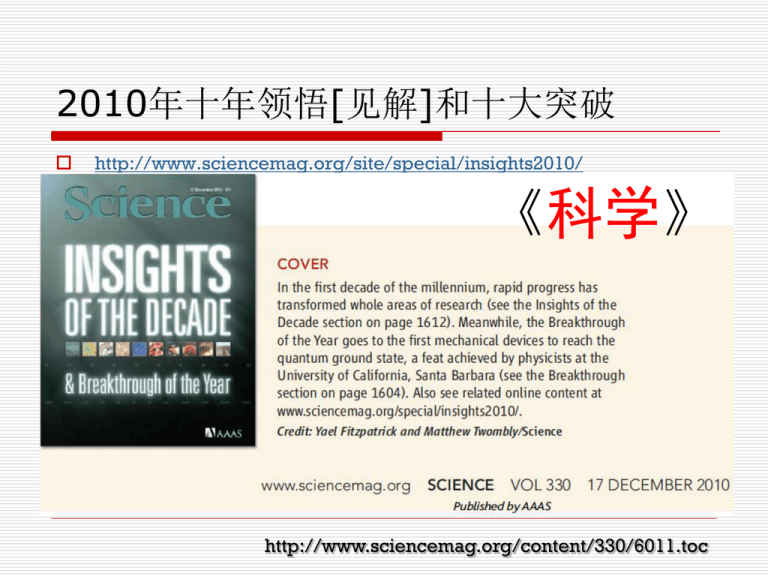
2010年十年领悟[见解]和十大突破
http://www.sciencemag.org/site/special/insights2010/
http://www.sciencemag.org/content/330/6011.toc
《科学》
http://www.sciencemag.org/content/330/6011.toc
精确宇宙学
世纪之交-----3朵乌云:3D宇宙
[eprint arXiv:1010.1307]
3D Universe
宇宙学家在做什么?
3件事!
1为什么!
2是什么!
3应该是什么!
我们的宇宙
Hubble参量观测数据与宇宙学模型限制
H(z)
the observational Hubble parameter data (OHD)
张同杰
马骢 [2010级硕士]
北京师范大学天文系
Hubble Parameter Cosmology or H(z)
Cosmology
Lensing cosmology
Lee Jounghun, Pen,Ue-Li. ApJ, 686: L1–L4, 2008
SN cosmology; GRB cosmology
Simulation, Weak lensing,
Wavelet
Zhang, Tong-Jie; Yu, Hao-Ran; et al, ApJ, 728, 35
Yu, Hao-Ran; Zhang, Tong-Jie et al arXiv:1012.0444
Hubble parameter H(z)
Cosmological application:
Joan Simon, Licia Verde, and Raul Jimenez. PRD 71, 123001 (2005)
Luminosity distance VS Hubble parameter
1. The integral smears out information about E o S
2. The integral make the luminosity distance have only a weak
discriminating power with respect to different possible histories of E o S
Limitations using luminosity distance
2001 PRL 86
今天Outline
一. Observational methods for H(z)
二. Power of Observational Hubble
parameter data[OHD] -- H(z)
三、Future of OHD
一. Observational methods for H(z)
1. the differential age method: different age
of the oldest galaxies in each redshift bin;
2. the radial BAO size method: the baryon
acoustic oscillation (BAO) along the
line-of-sight direction from the spectroscopic
galaxy samples;
3. the GW method: compact-binary objectobservation.
1. the differential age method
1. Measure the age difference, Dt, between two passively
evolving galaxies that formed at the same time but are
separated by a small redshift interval Dz;
2. Infer the derivative dz/dt from the ratio Dz/Dt.
At high redshifts, z=1–2, H(z) would constrain the EoS of DE,
while at low redshifts, z<0.2, it would determine the Hubble
constant, H_0.
Galaxies samples:
The fair samples of passively evolving galaxies
1.Similar metallicities
2. Low star formation rates (i.e., a red color)
So, the average age of their stars would far
exceed the age difference between the two
galaxy samples.
Age-redshift relation of the galaxies
----Edge or Envelope
Joan Simon, Licia Verde, and
PRD 71, 123001 (2005)
Raul Jimenez [upenn].
9 data point = 8+1
1 data---Sloan Digital Sky Survey(SDSS)[R. Jimenez et al, ApJ.593,
622 (2003)]
8 data----GeminiDeep Survey (GDDS) survey [R. G. Abraham et al.,
Astron. J. 127, 2455(2004)] and archival data [T. Treuet al, MNRAS.
308, 1037 (1999)]
Key advantage
Differential ages are less sensitive to
systematics errors than absolute ages.
Two new H(z) data sets
Stern, D., Jimenez, R.et al. 2010, JCAP 02(2010)008 [astroph/0907.3149]
Two samples: 1. the SPICES sample. Most of the spectra were
taken at the Keck telescope; 2. The VVDS [49] is the VIMOSVLT survey carried out by the VLT/ESO telescope
1+8+2=11
2. the radial BAO size method
the baryon acoustic oscillation (BAO)
along the line-of-sight direction from the
spectroscopic galaxy samples
Looking back in time; angles imply distance
D. J. Eisenstein et al., Astrophys. J. 633, 560 (2005)
CREDIT: WMAP & SDSS websites
CMB
Detection of BAO
GALAXIES
standard ruler
BAO method
The comoving sizes of cosmological object
[standard ruler] of feature at redshift z
in line-of-sight and transver
directions
observed sizes
Two-point correlation function
Updated data sets:
13=[1+8+2] 11 [OHD] + 2 [BAO]
1. Ma Cong, Zhang Tong-Jie [arXiv:1007.3787] ApJ, 730:74 (8pp), 2011
2. Zhang, Tong-Jie; Ma, Cong; Lan, Tian
Hindawi Publishing Corp. Hindawi Publishing Corporation
Advances in Astronomy Volume 2010, Article ID 184284, 14 pages [eprint arXiv:1010.1307]
Ze-Long,yi, Tong-Jie Zhang,
Modern Physics letters A, 22,41-53(2007) ( arXiv:astro-ph/0605596)
(arXiv:astro-ph/0607301)
3. GW method-Standard siren[汽笛]
SN or Gamma ray burst [GRB]—
electromagnetic wave--standard candle
[gamma-ray bursts]
Compact-binary object-- continuous GW—
determine luminosity distance to the
binaries with a high precision
standard
siren
Future space-based gravitational wave detectors
Such as DECI-hertz Interferometer Gravitational-wave
Observatory (DECIGO) and Big-Bang Observer (BBO)
1. sensitive to GW in 0.1-1Hz band
2. detect GW sources
[1]. Cosmological GW background during Inflation
[2]. Mergers of an intermediate-mass black hole
[3]. A large number of(10^6) neutron star (NS) binaries:
cosmological parameters can be accurately measured by
DECIGO and BBO with a precision of 1%.
The advantage of the standard sirens
number
1. the expected
of sources (NS binaries)
is much larger than that of the type Ia supernovae;
2. the sources are distributed deeply enough at
higher redshifts.
Atsushi et al arXiv:1011.5000
OHD from GW
二. Power of Observational Hubble paramer data H(z)
[eprint arXiv:1007.3787]
Two Questions
1. Can future observational determinations of the Hubble
parameter be used as a viable alternative to current SN Ia data?
2. If so, how many more data points need?
Answer via an exploratory, statistical approach with
simulated data
(1) simulated H(z) data sets;
(2) an “evaluation” model;
(3) a well-defined “figure of merit” (FoM).
Data set simulation
Error simulation
Upper line:σ+ = 16.87 z + 10.48,
Lower line:σ− = 4.41 z + 7.25
Midline:σ0 = 10.64 z + 8.86
Error: σ (z)-Gaussian N(σ0(z), ε(z))
where ε(z) = (σ+−σ−)/4.
Deviation simulation
Hsim(z) = Hfid(z) + ΔH with σ(z)
ΔH =Hsim(z)−Hfid(z)-Gaussian N(0,σ (z))
500 realization
Each-128 data points
Figure of Merit[FoM]
and The degeneracy of confidence regions
FoM-the area enclosed by the contour of P(Ωm,ΩΛ| {Hi}) =
exp(−Δχ2/2)Pmax, Δχ2 =6.17
Conclusions
1. more than 60 future measurements of H(z)[z-0-2]comparable with
those obtained: SN Ia ConstitutionT;
2. lower the error of future H(z) measurements to 3% , ∼60
measurements [z=0.1, 1.0] achieve the same result;
3. Our result furthers a conclusion of Lin et al. (2009) and Carvalho et
al. (2008), that OHD plays almost the same role as that of SNIa for the
joint constraints on theΛCDMmodel.
三、Future of OHD
1. Observational cost:
ConstitutionT data[Wei Hao]: a subset of the
Constitution compilation, a combination of the groundbased CfA3 SN observations (Hicken et al. 2009b) and
Union, a larger compilation of legacy SNe and spacebased observations (Kowalski et al. 2008). The CfA3
sample alone requires 10 nights for each of the 185
SNe observed.
OHD: The current OHD from age-dating does not
require space-based observations. Stern et al. (2010): 24
galaxy cluster containing target chronometer galaxies
were obtained in only two nights using the Keck I
telescope. Crawford et al. (2010): the South African
Large Telescope is capable of measuring H(z) to 3% at
an individual redshift in ∼180 hr.
2. Increase of quality and number
Crawford et al. (2010) analyzed the observational
requirement of measuring H(z) to 3% at intermediate
redshifts with age-dating.
The Baryon Oscillation Spectroscopic Survey (BOSS):
constrainH(z) with 2% precision at z ≈ 0.3,0.6 by measuring
BAO imprints in the galaxy field, and at z ≈ 2.5 using the Lyα
absorption spectra of quasars. And it also could extend H(z)
measurement into deeper redshift.
Future CMB observation programs, such as the Atacama
Cosmology Telescope[ACT], may be able to identify more
than 2000 passively evolving galaxies up to z ≈ 1.5 via SZ effect,
and their spectra can be analyzed to yield age measurements
that will yield approximately 1000 H(z) determinations with
15% error (Simon et al. 2005).
总的结论
the OHD set alone is potentially capable
of being used in place of current SNIa
data sets if it is large enough.
Ma, Cong; Zhang, Tong-Jie, ApJ,730,74 (2011). [eprint arXiv:1007.3787]
Open questions
1. 利用差分年龄观测,是否一定要用高分辨率光谱?是否可以
改变数据处理方式,通过类似于LAMOST的低分辨率光谱完成?
2. 星族形成、演化的模型对差分年龄有直接影响。
3. 利用差分年龄定H(z), 目前没有很系统的观测specification,
更没有专门化的观测计划。因此Fisher matrix的输入值还有
一些不确定性。
4. 21cm线,尚无高红移的直接观测。从现在到测出21cm背
景的BAO、乃至测出H(z), 还有多少路要走?
5. BAO用于宇宙学模型限制,特别是从BAO得到的H(z),并
没有完全消除对“fiducial model”的依赖性。这一点能否更好
地解决?
我们的关于H(z)的工作[10]
(1). Ma, Cong; Zhang, Tong-Jie, ApJ,730,74 (2011). [eprint arXiv:1007.3787]
(2). Zhang, Tong-Jie; Ma, Cong; Lan, Tian, Invited paper:
Advances in Astronomy, 184284(2010)[eprint arXiv:1010.1307]
(3). Zhai, Zhong-Xu; Wan, Hao-Yi; Zhang, Tong-Jie
Physics Letters B, Volume 689, Issue 1, p. 8-13(2010) (eprint arXiv:1004.2599)
(4). Wan, Hao-Yi; Yi, Ze-Long; Zhang, Tong-Jie; Zhou, Jie
Physics Letters B, Volume 651, Issue 5-6, p. 352-356 (08/2007) (arXiv:0706.2737)
(5). Yi, Ze-Long; Zhang, Tong-Jie,
Modern Physics Letters A, Vol. 22, No. 1 (01/2007) 41-53 (arXiv:astroph/0605596)
谢谢!


